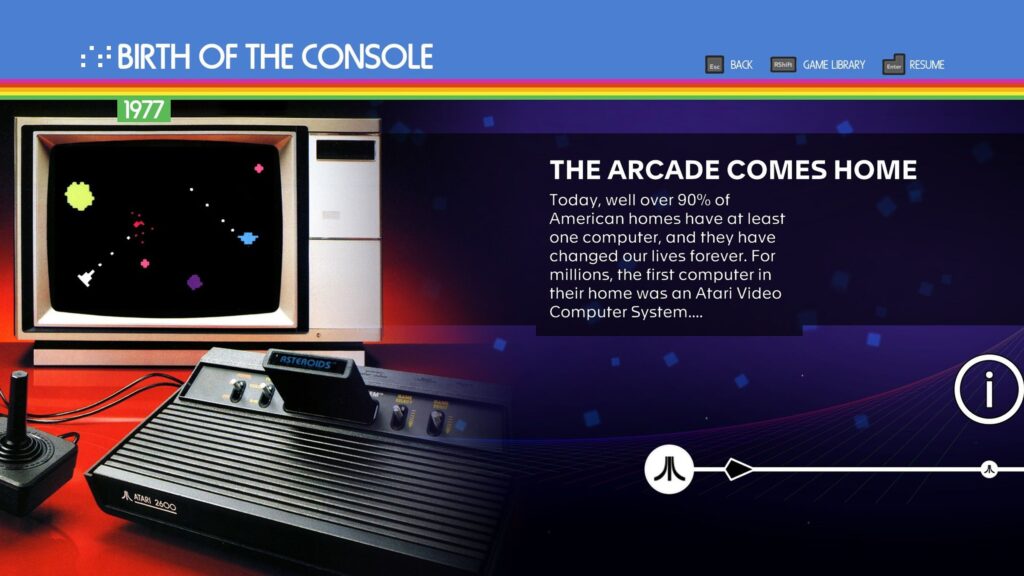One of the biggest challenges in video game preservation is figuring out how to actually present old games. In 2022, there are more ways than ever to play the classics, whether it’s mini consoles, updated hardware, subscription services, retro collections, or modern rereleases. While these can make old games playable to new audiences, they aren’t always able to put them in a proper context — which is especially important for really old games like, say, Adventure on the Atari 2600.
But an expansive new release, made by Digital Eclipse to celebrate Atari’s 50th anniversary, is the best attempt at a retro collection I’ve ever experienced. It’s available on just about every console out there right now as well as the PC, letting me put my PS5 to use for its intended purpose: playing Asteroids. The collection is huge, detailed, and does an amazing job of explaining why these games are so important.
The first thing to know about Atari 50: The Anniversary Celebration is that it is absolutely massive. It has more than 90 games spanning a few decades of history. Most of them come from the 2600 and arcades, but there are also PC games, 7800 updates, and a handful of titles from ill-fated devices like the Jaguar and Lynx. Rounding out the package are a number of unreleased prototypes, like the sequel to Yars’ Revenge and updated or reimagined versions of games like Haunted House and Breakout. Outside of the games themselves, the collection is packed with things like short documentaries featuring the original developers; old photos, magazine articles, comic books; and high-quality versions of classic Atari box art. You can even see the original code for some games.
It is a seemingly overwhelming amount of stuff, but the team at Digital Eclipse has cleverly arranged it into a timeline. It’s divided into five different eras, starting with Atari’s arcade origins before moving into home consoles and PCs and ending with the dire days of the Jaguar. The timeline intersperses supplementary material alongside the games so that you can understand the context of a title before you play. You also aren’t forced to experience the timeline in any specific order. You can pick and choose what you see, delving into what’s most interesting and skipping over things you already know. It’s sort of like an interactive museum exhibit, only on your television.
This context is especially important because many of these games have not aged particularly well. Even as someone who loves retro games, I am completely flummoxed when I boot up something like Swordquest. But after watching some videos of the designer explaining his work and delving into the comic books that detail the backstory, I was able to appreciate the series much more. I still can’t say I enjoyed playing them, but having that context helped me understand that these very confusing mazes were actually an important point in the history of video games, helping pioneer action-adventure games as we know them. (Atari 50 even features a newly developed version of the previously unreleased fourth game in the series.)
I also really loved being able to compare different versions of games. For instance, I found myself really getting into Dark Chambers, an early dungeon crawler. I started out playing the Atari 7800 version and was impressed by its detailed characters and dungeons. Then I played the extremely stripped-down 2600 port and was able to appreciate how much of the game remained intact despite the vastly underpowered hardware. Playing Scrapyard Dog, an early Super Mario-style platformer, was a similar experience. First, I played the bright and colorful console release and then the surprisingly adept handheld version from the Lynx.
All of this is made easier by some modern touches. Everything is quick and snappy, so it’s easy to swap between titles, and Atari 50 has save states so that you won’t lose your progress when you do. You can also bring up the controls and original instruction booklets with a press of a button, which is especially important given that the controls can change from game to game and platform to platform. I should also note that you don’t have to experience Atari 50 as a timeline: if you want, you can just play the games from a list as in most retro collections.
But that timeline is what makes this collection so special. Without it, I would’ve probably played most of these games for a few minutes and then moved on; with it, I’m much more invested in understanding what they are and how they fit into gaming history, and I know what to look for when I dive in. That said, there are a few notable omissions. Since Atari 50 only has a few third-party titles included, important releases like the infamous E.T. on the Atari 2600 and the beloved Alien vs Predator on the Jaguar aren’t available. And while it’s no fault of the team at Digital Eclipse, I must reiterate that many of these games aren’t very fun to play in 2022. As a kid, I always thought the 3D Jaguar fighter Fight for Life looked incredible in magazine screenshots, and three decades later, I was able to experience just how awful it truly is.
That doesn’t take away from what an achievement Atari 50 is. It’s so detailed and sprawling that it feels like a history lesson told in a way that’s completely native to video games. The biggest compliment I can give it is that I now want this for every retro collection. Imagine the likes of Nintendo, Sega, or PlayStation getting similar treatment. It’s a pipe dream, but it’s one Atari 50 makes me want to come true very badly.
Atari 50: The Anniversary Celebration launches November 11th on the Xbox, PlayStation, Nintendo Switch, and Steam.

